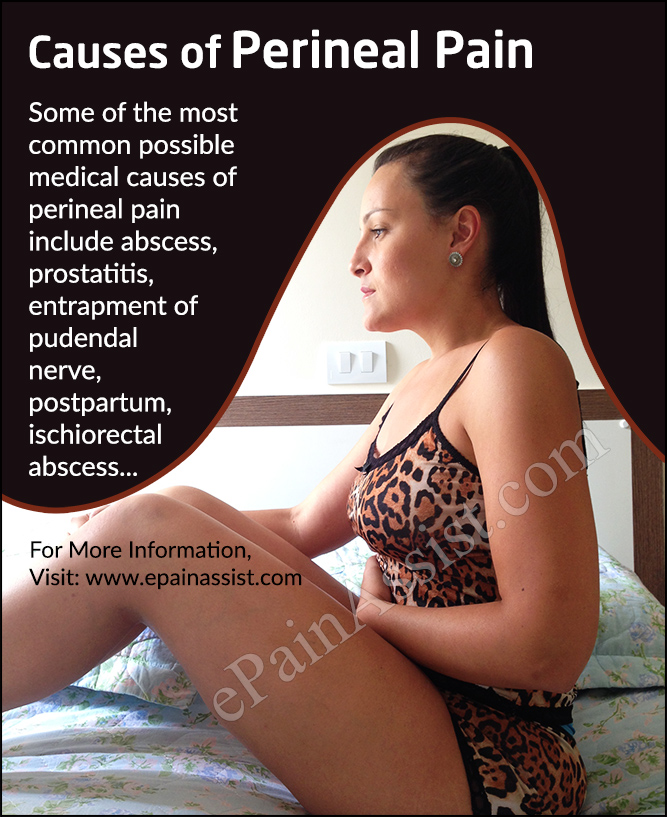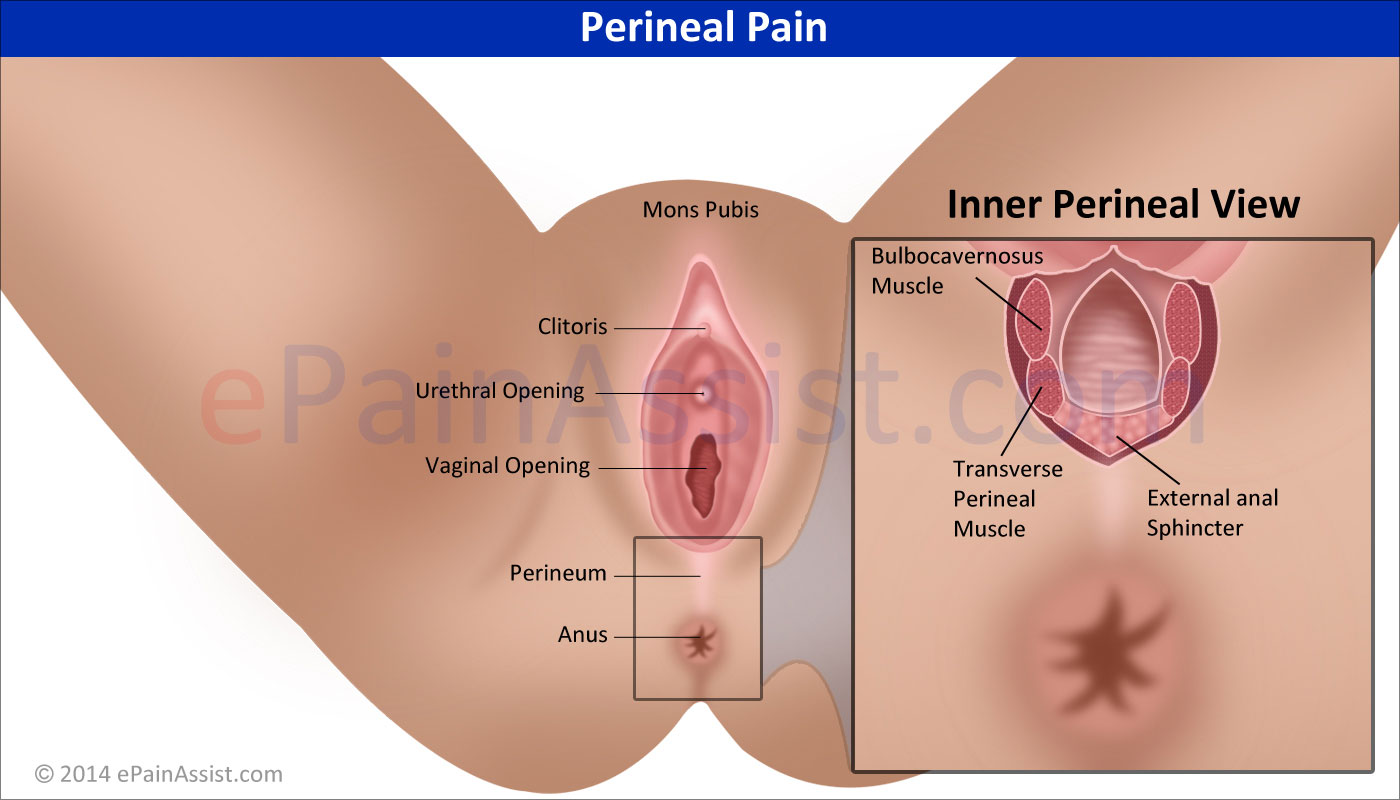Perineal pain is known as perineum pain. In men, the area between the testicles and the anus is called perineum. In women, the area between the vagina and the anus is called perineum. Perineal pain or perineum pain is also known as groin pain, pelvic pain, lower abdominal pain or genital pain.
Both men and women equally get affected by the symptoms of perineal pain or perineum pain. In chronic conditions, the persistence of perineal pain or perineum pain will be for over a period of three or more months. If the duration is lesser than this, then it is called acute perineal pain or acute perineum pain.
Most of the times, it is very confusing to determine the exact area of pain in the pelvic or lower abdominal area.
It is very important to differentiate the exact character of pelvic or perineal pain. Pain is either acute or chronic. The description of pain may suggest pain is intermittent or continuous. Individual may describe pain as sharp pain, discomfort, burning, squeezing, fullness, piercing or stabbing pain. Intensity of pain could be mild, moderate, severe or very severe. The most common pain is acute pelvic pain which the patient usually experiences after surgery or soft tissue trauma. Such pain is acute and burning pain. The deep perineal pain caused by penetrating injury is often described as burning and stabbing pain. The pain following surgery is described as continuous piercing pain. Most of the perineal pain or perineum pain disappears once the wound is healed. Occasionally perineal pain may last longer. Such chronic perineal or perineum pain lasting over 3 to 6 months are caused by infection and abscess formation within infected tissue.
Women tend to experience perineal pain or perineum pain at some point of time in their lives. The perineal pain in female often is associated with itching and skin color changes. Such pain is most often caused by skin reaction to lotion or soap. Occasionally perineal pain and itching is caused by skin diseases like scabies and ring worm. Diseases of lower abdomen or pelvic organ like uterus, vagina, urinary bladder, rectum and anus also causes pain in perineum.

Causes of Perineal Pain or Perineum Pain
Causes of Perineal Pain In Both Male And Female-
- Diseases of skin- Boil, carbuncle, furuncle and cellulitis
- Perineural cyst
- Perineal muscle spasm1
Abscess-
- Subcutaneous perineal abscess
- Ischio-rectal abscess
- Femoral hernia
- Obstructed inguinal hernia
- Urethritis and cystitis
- Renal calculi
- Entrapment of pudendal nerve (Pudendal Neuralgia)
- Trauma- Penetrating or Blunt Injury Of Perineum
Psychogenic pain
- Colitis – Inflammation or infection of colon can cause perineal pain or perineum pain.
- Proctitis – Inflammation or infection of rectum or anus.
- Appendicitis – Inflammation or infection of appendix/bowel can cause severe pain in perineal region.
Causes of Perineal Pain In Male-
- Prostatitis2
- Benign or malignant cancer of prostate
- Ejaculatory duct obstruction
- Testicle Diseases
Causes of Perineal Pain In Female
- Postpartum,
- Vaginal infection
- Vulvitis- Infection of vulva
- Ovarian Cysts – The ovaries produce a large cyst, which may be painful and rupture.
- Endometriosis – Pain that is caused by tissues that are outside uterus.
- Ectopic Pregnancy – It is a pregnancy that is implanted outside uterus and causes perineal pain or perineum pain in women.
- Pelvic inflammatory disease – Pain that is caused by damage likely from infections.
- Ovarian torsion – Twisting of ovary in such a way that it interferes blood flow can cause perineal pain or perineum pain in women.
- Dysmenorrhea – Abdominal pain during menses.
Signs and Symptoms of Perineal Pain or Perineum Pain
Perineal Pain And Symptoms Of Skin Disease- Skin disease causes following symptoms
- Swelling and edema of skin of perineum
- Skin discoloration- red skin when skin infection is caused by cellulitis
- Signs of skin diseases like boil, carbuncle and furuncle.
Perineal or Perineum Pain And Generalized Symptoms Of Infection- Acute or chronic perineal or perineum burning pain is caused by infection of pelvic organ. Such pain is associated with several other symptoms and signs. Infection of urinary bladder, prostrate, ovary, uterus and vagina causes perineal pain. The associated symptoms and signs of infection and perineal pain are as follows-
Symptoms of Perineal or Perineum Pain and Urinary Tract Infection:
- Perineal and pelvic pain
- Increase frequent of urination
- Purulent urethral discharge
- Increase urgency to urinate
- Sensation of burning pain during urination
- Urinary Incontinence– Loss of bladder control during laughing or coughing that results in urinary dribbling.
- Urinary Retention– Unable to urinate often seen in male suffering with prostate swelling.
Symptoms of Perineal or Perineum Pain and Lower Bowel Diseases- Rectal and anal diseases causes mild to severe pain. Characteristics of pain is intermittent or continuous and burning pain. Cancer of anus or cecum causes stabbing perineal or perineum pain. Other symptoms are as follows-
- Feeling of fullness of rectum,
- Painful defecation.
- Increased frequency or sedentary bowel movement,
- Feeling of increase swelling over suprapubic or perineal area,
- Pain refers to lower abdomen, waist, thighs and back
Symptoms of Perineal Pain and Traumatic Injury of Perineum-
Perineal injury is caused by either blunt or penetrating trauma. Blunt trauma causes split in skin and muscles that may get infected. Such infection may cause cellulitis and subcutaneous abscess. Penetrating injury caused by sharp object causes laceration and tear of superficial and deep tissue.
Injuries Caused By Blunt Trauma-
- Skin laceration
- Subcutaneous hematoma
- Subcutaneous abscess
- Pelvic fracture
Injuries Caused By Sharp Penetrating Object-
- Penetrating injury of perineal or perineum skin and subcutaneous tissue
- Perineal muscle tear
- Subcutaneous hematoma
- Anal sphincter laceration or tear
- Vaginal laceration or tear
- Laceration or 3rd degree tear of anus and anal sphincter
- Rectal wall penetrating injury leading to gas or fecal incontinence.
Psychosomatic Symptoms Associated With Perineal Or Perineum Pain-
Occasionally perineal pain or perineum pain is exacerbated and associated with symptoms of anxiety and depression. Pain sometime feels worst after prolong sitting. The psychosomatic symptoms observed are as follows-
- Depression
- Helplessness
- Anxiety
- Referred Perineal or Perineum Pain
Pain in most cases is localized over perineum but occasionally perineal pain is also referred to distant organ or dermatome as described below:
- Suprapubic pain
- Anorectal pain
- Genital pain
- Pain in tail bone
- Lower abdominal pain
- Urinary bladder pain
Risk Factors of Perineal Pain or Perineum Pain
Perineum is the anatomical part of the body that lies between the lower leg. The skin is exposed to trauma during activities. The risk factors are as follows:-
- Obesity-Obese or overweight individual often has a problem of skin friction between the leg while walking because of increase mass of leg and scrotum. The perineum is constantly rub between the leg and that often causes infection of hair follicle and subcutaneous tissue.
- Excessive Sweating– Excessive sweating causes skin laceration and damage to sweat gland as well as hair follicle. Such condition may cause cellulitis and subcutaneous infection.
- Posture-Perineal pain is frequently observed in individual spending several hours a day in chair while at work.
- Dehydration– Perineal infection is often seen in individual suffering with dehydration. The infection and injuries of hair follicle and sweat glands of skin is frequently observed in individual who is suffering with dehydrated skin.
- Anorexia- Anorexia causes weakness in skin elastic and fibrous tissue. Such condition exposes skin and subcutaneous tissue of perineum for infection.
Investigations Done to Diagnose Perineal Pain or Perineum Pain
Blood Examination-
- White blood cell (WBC) count- WBC count is increased in individual suffering with infection.
- Hemoglobin- Low hemoglobin is observed in individual suffering with perineal or perineum pain following perineal trauma resulting in bleeding and loss of blood.
- Urine Analysis
- Urine examination may show blood in urine as well as presence of bacteria when perineal pain is caused by urinary tract infection
Radiological Examination-
- X-Ray examination- X-ray of pelvic bone is performed to rule out fracture or dislocation of pelvic bones.
- CT (Computerized Tomography) and MRI (Magnetic Resonance Imaging)- – CT scan and MRI is performed to examine pelvic organs like uterus urinary bladder, ovary, fallopian tube, rectum, cecum and anus. CT scan is performed to rule out infection, tissue injuries and cancer growth.
Ultrasound-
- Ultrasound images shows bleeding, hematoma and cancer growth in perineum.
- Ultrasound images also used to diagnose inguinal and femoral hernia.
Treatment of Perineal Pain or Perineum Pain
Conservative Treatment for Perineal or Perineum Pain:
Rest- Three to four days of bed rest,
Diet-
- Avoid fatty and spicy food until pain subsides
- Adequate intake of water,
- Less consumption of alcohol,
- Heat- Place warm wet cloth or heating pad over perineum
- Cold- Place ice bag or frozen object over perineum
- Loose clothes- Wear loose underwear and pants.
- Perineal Massage Therapy- Pelvic floor muscle spasm and tender muscles are treated with perineal massage therapy.
Antibiotic Treatment for Perineal Pain or Perineum Pain:
- Perineal pain or perineum pain is often caused by infection of perineal skin, subcutaneous tissue or deeper tissue like anus, vulva and vagina. Infection is treated with antibiotics.
- Antibiotic treatment will be started when patient’s temperature is high, or if the patient has higher blood leukocytes.
Antipyretics-
NSAIDS- Fever is treated with non-steroidal anti-inhibitory drugs.
- Analgesics
- NSAIDs
- Tylenol
- Opioids
Interventional Pain Treatment for Perineal or Perineum Pain
- Caudal epidural steroid injection
- Pudendal nerve block
- Ganglion impar block3
Surgery for Perineal or Perineum Pain-
- Hernia repair
- Incision and drainage of abscess
- Repair of lacerated organs
- Removal of bladder and ureter stone
- Surgical repair of pelvic fracture
Recovery Period of Perineal Pain or Perineum Pain
Recovery period or healing time for chronic perineal or perineum pain will be for over a period of three or more months.
Recovery period of healing time for acute perineal or perineum pain will be less than 3 months.
References
Perineal Massage Improves the Dyspareunia Caused by Tenderness of the Pelvic Floor Muscles.
Silva AP1, Montenegro ML2, Gurian MB1, Mitidieri AM1, Lara LA1, Poli-Neto OB1, Rosa E Silva JC1.
Rev Bras Ginecol Obstet. 2017 Jan;39(1):26-30.
Chronic Prostate Inflammation Predicts Symptom Progression in Patients with Chronic Prostatitis/Chronic Pelvic Pain.
Nickel JC1, Freedland SJ2, Castro-Santamaria R2, Moreira DM2., J Urol. 2017 Jul;198(1):122-128.
Transcoccygeal neurolytic ganglion impar block for perineal pain: A case series.
Nalini KB, Shivanna S, Vishnu MS, Mohan CVR., J Anaesthesiol Clin Pharmacol. 2018 Oct-Dec;34(4):544-547. doi: 10.4103/joacp.JOACP_301_16.
Also Read:
- Bruised Buttock or Buttock Contusion: Causes, Signs, Treatment, Exercises
- Myofascial Pain in Buttock Muscles: Causes, Symptoms, Treatment, PT, Exercises
- What Can Cause Buttock Pain and How Can It Treated?
- What Can Cause Gluteal Pain or Pain in the Butt?
- What Causes Tingling or Itching in Anus & How to Get Rid of it?
- What is Rectum Infection & Bleeding & How is it Treated?

